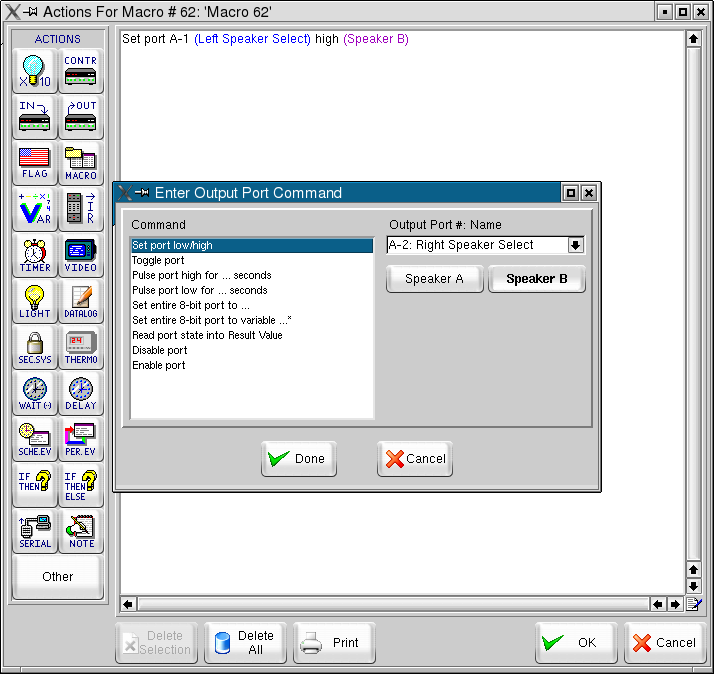HomeVisionXL programming
Lookup tables
When converting a value into another value cannot easily be done using a formula, a lookup table can be used. For each value between 0 and 255 a translated value can be defined. This may be useful for instance when a non linear sensor is connected to an analog input. A total of 32 lookup tables can be defined. The value is converted using the command:VAR = Value @ VAR in lookup table XX
I/O port level labels
Each input and output port has its own ideas of what "high" and "low" means for the attached equipment. For example: The Global Cache video probe gives a high output signal to indicate that a video signal is being detected. Their TV probe on the other hand pulls the input low when the TV is on. For this reason it is inconvenient to have to program your schedule using the terms "high" and "low" and having to remember what that really means. HomeVisionXL allows you to enter a short reminder of what "high" and "low" means on the summary screen.


Serial port names
The homevision controller supports a maximum of four serial ports. But who can (or wants to) remember if the thermostat is connected to port 2 and the alarm system to port 3 or the other way around? HomeVisionXL allows the user to give the serial ports a name. This greatly improves the chance that serial commands will be sent to the correct port without much effort from the schedule developer.Schedule notes
HomeVisionXL allows the user to attach some notes to a homevision schedule. This can be used to document how certain tasks involving a multitude of objects have been implemented, or information about experimental code that needs to be tested over time, or any other information you may want to store together with a schedule.Additional commands
- Additional Flag commands:
- Make flag equal to flag at variable XX
Make flag at variable XX equal to second flag
- Additional Variable commands:
- Variable @ VAR = second variable
Variable @ VAR = Result Value
Set bits in VAR from constant ...
Clear bits in VAR from constant ...
Set bits in VAR from second variable ...
Clear bits in VAR from second variable ...
Variable = Byte @ VAR in Text Storage Buffer
Put Variable into byte @ VAR in Text Storage Buffer
- Additional Output port commands:
- Set entire 8-bit port to variable ...
- Additional Controller commands:
- Set Baud Rate to 57600
Report controller status
Report status of all X10 modules
Report status of all flags
Report status of all variables
Report status of all input ports
Report status of all output ports
Report status of all analog ports
Report status of all digital temperature sensors
Recalculate scheduled events
Enable automatic reporting
Disable automatic reporting
Enable auto reporting of controller status
Disable auto reporting of controller status
Enable auto reporting of X-10 modules
Disable auto reporting of X-10 modules
Enable auto reporting of flags
Disable auto reporting of flags
Enable auto reporting of variables
Disable auto reporting of variables
Enable auto reporting of input ports
Disable auto reporting of input ports
Enable auto reporting of output ports
Disable auto reporting of output ports
Enable auto reporting of analog ports
Disable auto reporting of analog ports
Enable auto reporting of temperature sensors
Disable auto reporting of temperature sensors
- Additional Scheduled event commands:
- Enable Scheduled Event at Var ...
Disable Scheduled Event at Var ...
Do Scheduled Event at Var ... Now
- Additional Periodic event commands:
- Enable Periodic Event at Var ...
Disable Periodic Event at Var ...
Do Periodic Event at Var ... Now
Set Periodic Event at Var ... Rate To: ...
- Additional Phone commands:
- Put phone ring count into variable
Additional conditions
- Additional Flag conditions:
- Flag @ VAR is clear
Flag @ VAR is set
Flag @ VAR is neutral
Flag @ VAR is not clear
Flag @ VAR is not set
Flag @ VAR is not neutral
Next: Configuration